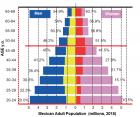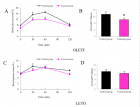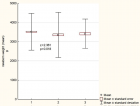Table of Contents
Practice patterns and outcomes of repository corticotropin injection (Acthar® Gel) use in childhood nephrotic syndrome: A study of the North American Pediatric Renal Trials and collaborative studies and the Pediatric Nephrology Research Consortium
Published on: 23rd July, 2021
OCLC Number/Unique Identifier: 9140608009
Objective: We set up a U.S. registry to examine prescription patterns and patient outcomes of repository corticotropin injection (Acthar® Gel) for childhood nephrotic syndrome.
Methods: 18 participating U.S. pediatric centers performed retrospective review and prospective observation of patients < 21 years old with nephrotic syndrome treated with Acthar Gel. We captured baseline characteristics, drug regimen and duration, and disease response following treatment.
Results: 46 patients, enrolled from 2015 to 2020 were included. 27 (58.7%) were male. 18 patients (39.1%) had a diagnosis of minimal change followed by focal segmental glomerulosclerosis in 16 patients (34.7%). Median age at start of treatment was 12.5 years (IQR 8.5-17.4) compared to 5.3 years at diagnosis (IQR 2.7-10.5 years). 52% were resistant to corticosteroids. The most common Acthar Gel regimen was 80IU twice a week with a median duration of 199 days (IQR 88-365). Among 37 patients with active disease, 18 (49%) were able to achieve partial or complete remission, though all patients that had a positive response were on other immunosuppressants concomitantly.
Conclusion: We report the findings of the largest registry cohort of pediatric patients in the U.S. treated with Acthar Gel for clinically challenging cases of nephrotic syndrome. Acthar Gel was successful in inducing remission in approximately half of the patients with active disease at time of treatment. No predictors of response with respect to demographic data, age at start of Acthar Gel therapy, etiology of nephrotic syndrome, presence or absence of comorbidities, or steroid responsiveness was noted.
Multifrecuency bioimpedance phase angle as a tool to predict maturation failure of native fistulae for hemodialysis
Published on: 21st July, 2021
OCLC Number/Unique Identifier: 9198828640
Background and objectives: An arteriovenous fistula is considered to be an ideal vascular access for patients receiving hemodialysis, its main limitation is its high failure rate to achieve maturation and long-term functionality loss. Multiple strategies have attempted to identify patients at risk. Bioelectrical impedance has shown to be a valuable resource in the determination of the hydration status, and the measurement of the phase angle through this method has demonstrated to be a good indicator of the nutritional state and its related as a general marker of survival. The objective of this study is to analyze the role of plasma albumin and phase angle measured through bioelectrical impedance as tools useful for predicting failure of arteriovenous fistulas.
Materials and methods: prospective observational study, including 104 patients with chronic kidney disease receiving hemodialysis who underwent a native arteriovenous fistula during a period of 24 months. Analyzing its clinical characteristics, laboratory and phase angle through electrical bioimpedance, both univariate and multivariate analysis was performed both with logistic regression, furthermore calculation of coordinates and ROC curve to establish a better cut-off point.
Results: of the variables that were analyzed only the phase angle measurement showed statistical significance OR 2.61 (1.6 – 4.4) p - value 0.001 for predicting arteriovenous fistula failure. In female patients with a phase angle value of 3.25 had a 90% sensibility and 53% specificity for male patients a value of 3.58 showed a sensibility of 84% and a specificity of 52% with ROC curve of 0.78.
Conclusion: phase angle through bioimpedance is a useful parameter, helpful in predicting failure of native arteriovenous fistula, it is also an important tool for identifying patients at risk, in early stages prior to the construction of a vascular access.
Usefulness of foot-to-foot bioimpedance analysis for assessing volume status in chronic hemodialysis patients at the Aristide Le Dantec University Hospital (Senegal)
Published on: 20th July, 2021
OCLC Number/Unique Identifier: 9198815507
Introduction: Determination of dry weight is one of the daily goals to achieve in hemodialysis. The aim of this study was to validate the use of bioelectrical impedance analysis (BIA) in estimation of dry weight in a population of Senegalese chronic hemodialysis patients.
Patients and methods: A 9-week cross-sectional study was carried out at the hemodialysis unit of Aristide Le Dantec University Hospital. Adult patients with no previous hospital history were included. The total body water (TBW) was measured with a single frequency bioelectric impedance foot-to-foot analyzer, before and after six successive hemodialysis sessions. These results were compared with those from clinical measurements with the Watson equation using a Student’s t-test and Bland-Altman analysis.
Results: 264 measurements were made in 22 patients (46.6 years, 54.5% men, 92.3 months on dialysis, 62.7 kg mean dry weight). A significant reduction in weight (ΔWeight = 2.0 ± 1.1 kg; p < 0.0001) and in TBW measured by the BIA (ΔTBWBIA = 3.3 ± 1.0 liters; p < 0.0001)) or calculated by Watson’s equation (ΔTBWWatson = 0.5 ± 0.2 liter; p = 0.0001) was observed. There was a strong linear correlation and agreement between the 2 TBW measurements in pre-dialysis. In post-dialysis the concordance diagram indicated a bias = –2.2 and wide agreement limits.
Conclusion: The BIA allows reproducible and reliable measurements and a fair estimate of the TBW in pre-dialysis.
Acute Kidney Injury due to spontaneous Atheroembolic disease, superimposed on diabetic nephropathy, with no recent vascular or cardiac intervention, presented as Rapidly Progressive Glomerulonephritis (RPGN)
Published on: 14th July, 2021
Atheroembolic disease (AED), or Cholesterol Crystals Embolism, is a systemic disease presented as a complication of severe atherosclerosis [1], where older age, male sex, diabetes hypercholesterolemia, smoking and hypertension [2], are the main risk factors for the development of Atherosclerosis, it is known that spontaneous atherosclerotic renal disease is rare in the absence of any vascular intervention [3], and in the absence of anticoagulant [4], or the absence of calcified aorta, with the most common presentation of the disease is subacute kidney injury progress into renal dysfunction occurs in like a staircase pattern and the renal dysfunction is usually observed several weeks after a possible intervention, caused by dislodging the micro cholesterol plaques from a major artery, and start showering multiple organs causing micro and macro embolic phenomena.
In our case, we report acute kidney injury on a previously stable kidney disease in a female with diabetes mellitus type 2 presented with severe anemia, dyspnea, massive fluid overload with bilateral pleural effusion, patient had a history of multiple IV contrast exposures, with peripheral vascular occlusive disease (PVOD), required amputation of right below the knee amputation, presented during the COVID-19 pandemic, found with nephrotic syndrome, a kidney biopsy has shown cholesterol crystal embolization compatible with Athero-embolic Disease with severe Diabetic Nephropathy.
Impact of a multidisciplinary pre-dialysis program on renal treatment modalities choice
Published on: 5th May, 2021
OCLC Number/Unique Identifier: 9124546591
In Portugal, around 2500 patients with end-stage chronic kidney disease (CKD stage 5) start a renal replacement therapy (RRT) for the first time each year [1]. They have four main treatment options: kidney transplantation (TX); haemodialysis (HD); peritoneal dialysis (PD) and conservative treatment (CT). RRT selection is quite complex due to the specificities of each option and to their profound effect on patient’s quality of life. Patients must play a decisive role in the choice of treatment modality and select the option that best suits to their values and needs.

HSPI: We're glad you're here. Please click "create a new Query" if you are a new visitor to our website and need further information from us.
If you are already a member of our network and need to keep track of any developments regarding a question you have already submitted, click "take me to my Query."























































































































































